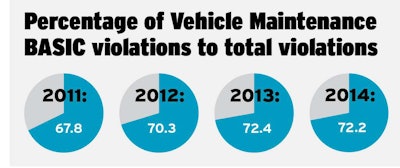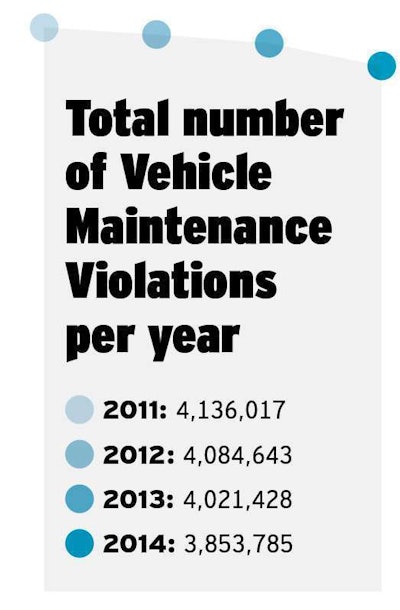When it was introduced last decade, the Federal Motor Carriers Safety Administration’s (FMCSA) Compliance Safety and Accountability (CSA) program was touted as the future of safety in heavy-duty trucking.
Now almost five years later, CSA remains the industry’s grandest, most-expansive performance monitoring program in history.
CSA monitors fleets and drivers on seven different behavior analysis and safety improvement categories, called BASICs. While most of these categories are geared toward driver attentiveness, capability and performance, the last five years have shown the one BASIC vehicle owners have the toughest problem managing isn’t driver health or skill related—it’s vehicle maintenance.
Since being implemented in December 2010, more than 70 percent of all CSA violations found during fixed and roadside inspections in the United States have fallen under the Vehicle Maintenance BASIC.
That’s more than 16.7 million violations in total (through February), or 10,774 per day.

Inspection data analysis can deliver aftermarket businesses violation trends specific to their individual markets, and allow them to tailor sales plans to best fit the customers they serve.
CSA highlights customers’ problems; CSA data shows the aftermarket exactly how to provide solutions, says James Vogel, general manager at RigDig and vice president of business analytics at Randall Reilly.
CSA data “helps a service provider identify fleets who could use their services,” he says.
FMCSA says approximately 95 percent of CSA vehicle inspection data available today is the result of fixed or roadside inspections performed by state inspectors and submitted to FMCSA.
Each inspection “determines whether the driver and/ or the commercial vehicle carrier is in compliance with the Federal Motor Carrier Safety Regulations or the Hazardous Materials Regula- tions, as appropriate. Serious violations result in the issuance of vehicle or driver out-of-service orders. These violations must be corrected before the affected driver or vehicle can return to service,” FMCSA says.
![[ click to enlarge + ]](https://img.truckpartsandservice.com/files/base/randallreilly/all/image/2015/12/tps.graf2.png?auto=format%2Ccompress&fit=max&q=70&w=400) [ click to enlarge + ]
[ click to enlarge + ]But aftermarket businesses can gleam plenty of information from inspection data alone.
Records of every vehicle inspection submitted to FMCSA since CSA’s introduction in 2010 are available for purchase, and FMCSA provides inspection updates to data subscribers on a monthly basis.
Vogel says it doesn’t take long once you start leafing through inspection data for trends to emerge.
And when supplemented with carrier information and vehicle population statistics, Vigillo CEO Steven Bryan says aftermarket businesses can really capitalize on the sales potential CSA has dropped in the industry’s lap.
Now five years into CSA, he’s surprised more aftermarket businesses aren’t doing so already.
“I think that’s been a headscratcher for me from the very beginning,” Bryan says. “Maintenance [businesses] have never really gotten heated up about CSA data and I don’t know why.

It’s with that in mind that Truck Parts & Service has turned to RigDig to help highlight national inspection statistics and trends that have appeared during the first five years of CSA program.
Though these trends only scratch the surface of the information capable of ex- traction from CSA data, they clearly show the detail and specificity in which inspec- tion data can help inform and educate aftermarket businesses.
When evaluated further and coupled with carrier information, Vogel says inspection data can become the ultimate targeted marketing tool, showing pains points and “areas of improvement opportunity” for any fleet customer.
“There are oceans of data out there swamping us,” adds Bryan. “You can comb through [the] billions of lines of data for records of a specific company or look at the industry at large.”










